Products You May Like
Imagine the future. Where is it for you? Do you see yourself striding towards it? Perhaps it’s behind you. Maybe it’s even above you.
And what about the past? Do you imagine looking over your shoulder to see it?
How you answer these questions will depend on who you are and where you come from. The way we picture the future is influenced by the culture we grow up in and the languages we are exposed to.
For many people who grew up in the UK, the US and much of Europe, the future is in front of them, and the past is behind them. People in these cultures typically perceive time as linear. They see themselves as continually moving towards the future because they cannot go back to the past.
In some other cultures, however, the location of the past and the future are inverted. The Aymara, a South American Indigenous group of people living in the Andes, conceptualise the future as behind them and the past in front of them.
Scientists discovered this by studying the gestures of the Aymara people during discussions of topics such as ancestors and traditions. The researchers noticed that when Aymara spoke about their ancestors, they were likely to gesture in front of themselves, indicating that the past was in front.
However, when they were asked about a future event, their gesture seemed to indicate that the future was perceived as behind.
Look to the future
Analysis of how people write, speak and gesture about time suggests that the Aymara are not alone. Speakers of Darij, an Arabic dialect spoken in Morocco, also appear to imagine the past as in front and the future behind. As do some Vietnamese speakers.
The future doesn’t always have to be behind or in front of us. There is evidence that some Mandarin speakers represent the future as down and the past as up.
These differences suggest that there is no universal location for the past, present and future. Instead, people construct these representations based on their upbringing and surroundings.
Culture doesn’t just influence where we see the position of the future. It also influences how we see ourselves getting there.
In the UK and US, people typically see themselves as walking with their faces pointing forward towards the future. For the Māori of New Zealand, however, the focus of attention when moving through time is not the future, but the past.
The Māori proverb Kia whakatōmuri te haere whakamua, translates as “I walk backwards into the future with my eyes fixed on my past”.
For the Māori, what is in front of us is determined by what can or has been seen. The Māori consider the past and present as known and seen concepts because they have already happened. The past is conceptualised as in front of a person, where their eyes can see them.
The future, however, is considered unknown because it has not happened yet. It is thought of as behind you because it is still unseen. Māori perceive themselves as walking backwards rather than forwards into the future because their actions in the future are guided by lessons from the past. By facing the past, they can carry those lessons forwards in time.
Different approaches
Scientists are not sure why different people represent the past, present and future differently. One idea is that our perspectives are influenced by the direction that we read and write in.
Research shows that people who read and write from left to right draw timelines in which the past is on the left and the future is on the right, reflecting their reading and writing patterns.
However, people who read from right to left, such as Arabic speakers, often draw timelines with events from the past on the right and the future on the left. However, reading direction cannot explain why some left-right reading people think of the future as “behind”.
Another theory is that cultural values may influence our orientation to the future. Cultures vary in the extent to which they value tradition. Researchers believe your spatial concept of the future may be determined by whether your culture emphasises traditions of the past or focuses on the future.
In cultures that stress the importance of progress, change and modernisation, the future is normally in front – for example, the UK and the US.
However, in cultures that place a high value on tradition and ancestral history, such as in Morocco and indigenous groups such as the Māori, the past is the focus and is therefore usually in front.
These differences may also have implications for initiatives to tackle global challenges. If the future is not always in front, then western campaign mantras about “moving forward”, “moving on” and “leaving the past behind” may lack resonance for many people.
Perhaps, however, if we can learn from other cultures’ representations of time, we may be able to reframe our understanding of some of the world’s most pressing problems.
Approaching the future with regular looks over the shoulder to the past could lead to a fairer future for everyone.![]()
Ruth Ogden, Professor of the Psychology of Time, Liverpool John Moores University
This article is republished from The Conversation under a Creative Commons license. Read the original article.
